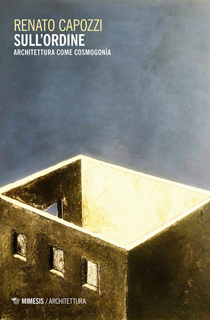
The study of an architect
After
reading Renato Capozzi’s latest book, one is sucked into a sense
of vertigo, if not the same, at least similar to what one feels after
getting up from one’s desk as an architect: paperwork everywhere,
notes, sketches; disorder, one would be led to think, and indeed this
would be the case, except for the decisive detail that all this mass of
reflections poured onto paper and scattered around is aimed at a
purpose, that of giving rise to a form, through a project.
On the surface, the book takes the form of a descent into the
Maelström, where instead of shipwrecks, wreckage and junk of all
kinds, there are instead transcribed excerpts of other people’s
thoughts, at the foot of which comments are noted down, which may or
may not turn into ideas, but which are there; clues that the mind
searches for in order to find a direction, a way, a thread that binds
them.
Notes and thoughts, fused together, like a sequence of works that have
been constructed and even only thought about (as when the author
mentions the succession of buildings that Mies designed without them
being realised, including the pavilion for the Brussels International
Exhibition, the 50x50 house, the Bacardi headquarters in Santiago de
Cuba, the latter two prefigurations of what would find completed form
in the Neue Nationalgalerie in Berlin), almost like a collage of
passages elaborated in such a sequence as to induce one to investigate
the possibility that the meaning of the quoted texts may have been
slightly shifted, an operation that must be carried out while remaining
extremely careful, because the risk always lurking is that of
manipulating them for purposes quite different from those for which
they were conceived.
This is not the case - at least it seems to me - in this very recent
study, where the passages cited converge to establish an extended
reflection on order, without, however, allowing oneself to be dazzled
by the authority of those who formulated the propositions as if by
dogma, and on the contrary finding a possible logical sequence among
them, or at least offering scholars an attempt to reconstruct one, thus
constituting very fertile material for investigation.
Certainly this book could be inscribed in the tradition dating back to the ancient era, of texts that scholars, philosophers and sages consulted to draw thoughts for quotation (one result among others: the letters that Seneca wrote to Lucilius), and in this respect, the repertory presented by Capozzi is formidable; not a manual of composition, but something that is placed before it, identifying the prerequisites of coherence; nor, as some might believe, a text on an alleged mission of architecture, because at the end, the author leads a reflection on the order that he himself reserves the right to develop further, and we are certain that he will not miss the opportunity to read the future results of this development. Valuable in this respect is the reference to a text by Alberto Cuomo where he refers to Ernst Hans Gombrich, the author of a very full-bodied volume whose title Cuomo uses for his own writing, Il senso dell’ordine (translated into Italy by Einaudi forty years ago and unfortunately not reprinted since 1990), Gombrich being a historian, not an architect, and yet in his own way a composer - in the sense of the training as a classical musician with stringed instruments he received in his youth - coming from that Viennese milieu of a century ago, where much of contemporary thought (including architecture: for Adorno, Adolf Loos was the most revolutionary of architects) that is still an object of meditation took shape, and which will undoubtedly prompt future reflections on architecture.
Pierpaolo Gallucci
Book
Author:
Renato Capozzi
Title:
Sull’ordine. Architettura come cosmogonia
Language:
Italian
Publisher:
Mimesis, Milano-Udine
Charachteristic:
14x21 cm, 144 pages
ISBN:
9788857595313
Year:
2023